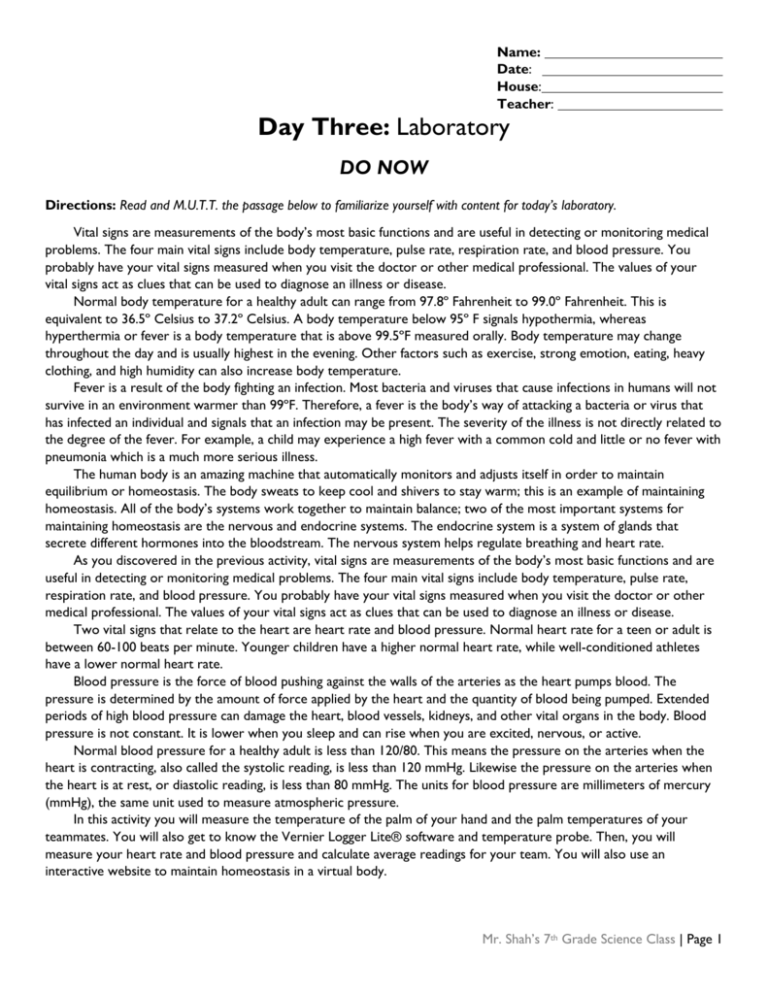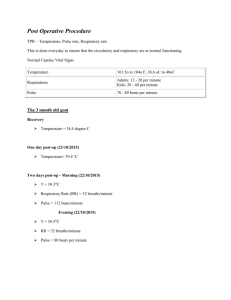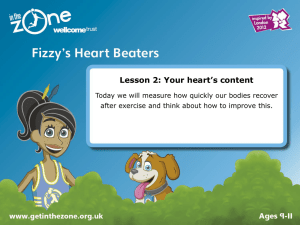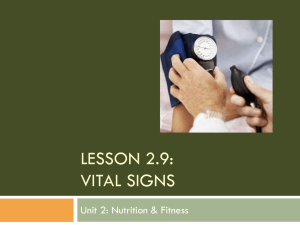Cardiovascular
advertisement

Name: Date: House: Teacher: Day Three: Laboratory DO NOW Directions: Read and M.U.T.T. the passage below to familiarize yourself with content for today’s laboratory. Vital signs are measurements of the body’s most basic functions and are useful in detecting or monitoring medical problems. The four main vital signs include body temperature, pulse rate, respiration rate, and blood pressure. You probably have your vital signs measured when you visit the doctor or other medical professional. The values of your vital signs act as clues that can be used to diagnose an illness or disease. Normal body temperature for a healthy adult can range from 97.8º Fahrenheit to 99.0º Fahrenheit. This is equivalent to 36.5º Celsius to 37.2º Celsius. A body temperature below 95º F signals hypothermia, whereas hyperthermia or fever is a body temperature that is above 99.5ºF measured orally. Body temperature may change throughout the day and is usually highest in the evening. Other factors such as exercise, strong emotion, eating, heavy clothing, and high humidity can also increase body temperature. Fever is a result of the body fighting an infection. Most bacteria and viruses that cause infections in humans will not survive in an environment warmer than 99ºF. Therefore, a fever is the body’s way of attacking a bacteria or virus that has infected an individual and signals that an infection may be present. The severity of the illness is not directly related to the degree of the fever. For example, a child may experience a high fever with a common cold and little or no fever with pneumonia which is a much more serious illness. The human body is an amazing machine that automatically monitors and adjusts itself in order to maintain equilibrium or homeostasis. The body sweats to keep cool and shivers to stay warm; this is an example of maintaining homeostasis. All of the body’s systems work together to maintain balance; two of the most important systems for maintaining homeostasis are the nervous and endocrine systems. The endocrine system is a system of glands that secrete different hormones into the bloodstream. The nervous system helps regulate breathing and heart rate. As you discovered in the previous activity, vital signs are measurements of the body’s most basic functions and are useful in detecting or monitoring medical problems. The four main vital signs include body temperature, pulse rate, respiration rate, and blood pressure. You probably have your vital signs measured when you visit the doctor or other medical professional. The values of your vital signs act as clues that can be used to diagnose an illness or disease. Two vital signs that relate to the heart are heart rate and blood pressure. Normal heart rate for a teen or adult is between 60-100 beats per minute. Younger children have a higher normal heart rate, while well-conditioned athletes have a lower normal heart rate. Blood pressure is the force of blood pushing against the walls of the arteries as the heart pumps blood. The pressure is determined by the amount of force applied by the heart and the quantity of blood being pumped. Extended periods of high blood pressure can damage the heart, blood vessels, kidneys, and other vital organs in the body. Blood pressure is not constant. It is lower when you sleep and can rise when you are excited, nervous, or active. Normal blood pressure for a healthy adult is less than 120/80. This means the pressure on the arteries when the heart is contracting, also called the systolic reading, is less than 120 mmHg. Likewise the pressure on the arteries when the heart is at rest, or diastolic reading, is less than 80 mmHg. The units for blood pressure are millimeters of mercury (mmHg), the same unit used to measure atmospheric pressure. In this activity you will measure the temperature of the palm of your hand and the palm temperatures of your teammates. You will also get to know the Vernier Logger Lite® software and temperature probe. Then, you will measure your heart rate and blood pressure and calculate average readings for your team. You will also use an interactive website to maintain homeostasis in a virtual body. Mr. Shah’s 7th Grade Science Class | Page 1 I DO: Temperature Average Temperature: 98.6 degrees Fahrenheit Equipment Pencil Computer with Vernier Logger Lite® software Vernier Go!Temp Temperature Probe Beaker Water Procedure 1. Connect the Go!Temp temperature probe to the computer. 2. Open the data collection software program Logger Lite® and open the file “01 A Hot Hand” from the Middle School Science with Vernier folder. 3. Measure the temperature of the palm of your hand. a. Click Collect to begin data collection. This is a green button at the top right side of the screen. b. Pick up the Temperature Probe and hold its tip in the palm of your hand as shown in Figure 1. Data collection will end when 60 seconds have gone by. 4. Record your maximum temperature. a. Click the Statistics button. The statistics box will appear on the graph, displaying several statistical values for the data, including the minimum and maximum temperatures recorded during the collection period. b. In your data table, record the maximum temperature. c. Close the Statistics box. d. Choose Store Latest Run from the Experiment menu to store your data. 5. Prepare the Temperature Probe for the next run. a. Cool the Temperature Probe by placing it into a beaker of room-temperature water until its temperature reaches the temperature of the water. The temperature of the probe is displayed in the meter. b. Use a paper towel to dry the probe. Be careful not to warm the probe as you dry it. 6. Repeat Steps 3-5 for each person on your team. However, when you repeat the steps, after clicking the Statistics button, choose Latest: Temperature as the run for which you want the statistics. Then click OK to view the statistics for the latest run. Do not choose Store Latest Run after the last run. 7. Print copies of the graph as directed by your teacher. 8. Fill in the data table below and calculate the average maximum temperature for your team. Student Name Maximum Temperature ºC ºC ºC ºC Team Average ºC Mr. Shah’s 7th Grade Science Class | Page 2 WE DO: Heart Rate Equipment Pencil Stopwatch or clock with a second hand Automatic blood pressure device Procedure 1. View the following movie introducing the cardiovascular system. Your teacher may choose to show this to the entire class. http://kidshealth.org/kid/htbw/CSmovie.html 2. Measure your pulse and record the value on the data table. a. Place two fingers from your right hand on the inside of your left wrist. Do not use your thumb as it has a faint pulse and may change your reading. b. Use a stopwatch or clock with a second hand and count the number of beats you feel for 10 seconds. c. Multiply that number by 6 and record below. This is the beats per minute, or bmp. d. Record the data for your teammates and find the average. Student Name Heart rate bpm bpm bpm bpm Team Average bpm Mr. Shah’s 7th Grade Science Class | Page 3 YOU DO: Blood Pressure 1. To find blood pressure, your team will use the automatic blood pressure device. This device will also measure heart rate, or pulse in beats per minute. 2. Measure your blood pressure and record the value on the data table. a. Place the cuff on your left arm, taking care to line up the arrow indicating the artery with the inside of your elbow. The tubes should be running down toward your hand. b. Tighten the cuff around your upper arm so it does not slide around but not so tight that it is uncomfortable. c. Press the Start button on the monitor and keep your arm and hand still and relaxed. Allow the machine to tighten and relax. d. Record your reading on the data table below. e. Record the readings for your teammates and calculate the averages. Student Name Blood pressure Heart rate bpm bpm bpm bpm Team Average bpm Mr. Shah’s 7th Grade Science Class | Page 4 Name: Date: House: Teacher: EXIT TICKET Directions: For each of the patients below, state whether each of their vital signs are high, low, or normal. 1. A female infant spikes a 102.1 degree Fahrenheit fever. When she is taken to the emergency room, her heart rate is 124 beats/min, respirations are 38 breaths/min and her blood pressure is 85/60. 2. A 21 year old athlete runs track in college. He visits the doctor for a routine physical and his vital signs are taken as: pulse: 54 beats/min, respiratory rate: 12 breaths/min, blood pressure: 120/80. 3. An eighty three year old man has a history of heart disease and diabetes. In his assisted living home, a nurse monitors his vitals daily. Today he has a temperature of 98.8 deg F, a pulse of 102 beats per minute, a respiratory rate of 15 breaths per minute, and a blood pressure of 140/90. 4. A six year old girl develops a sore throat, but still begs her mom to let her go outside. Her mom, a trained nurse, agrees as long as her vitals are normal. Her temperature is 99.5 degrees Fahrenheit, her blood pressure is 100/70, her pulse is 76 beats per minute, and her respiratory rate is 20 breaths per minute. Mr. Shah’s 7th Grade Science Class | Page 5








